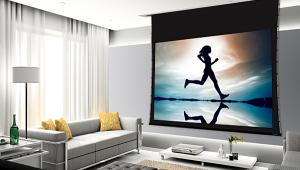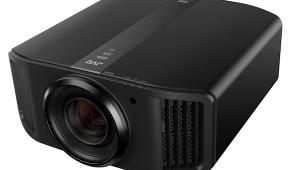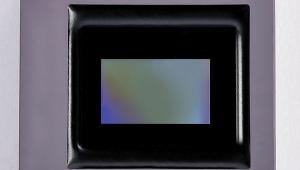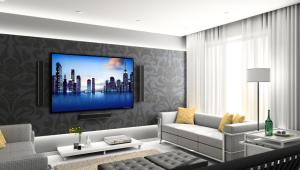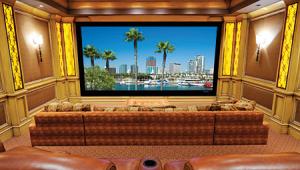Screening the Screens
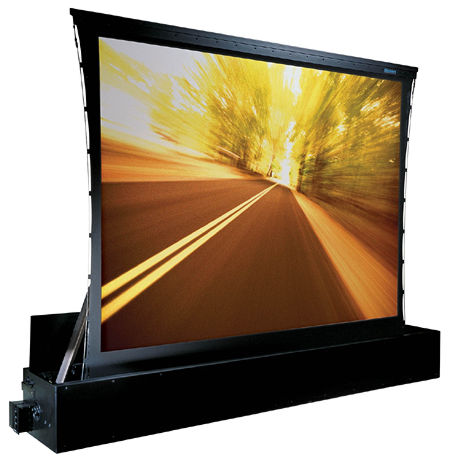
Everyone makes screens that retract upward, but many screen manufactures also make models that retract toward (or even into!) the floor, like this model from Stewart Filmscreen.
You've checked the prices and. . .sticker shock. Maybe you can just aim the projector at that white wall, or a neatly-pressed sheet.
Yes, you could. You'll get a picture, and the video police won't show up to drag you away to an ISF re-education camp. But the screen is an integral part of any projection system—front or rear—and any attempt at a makeshift substitute simply won't get the best out of your expensive projector investment.
Lights Out!
All the discussions herein assume a completely light-controlled room. That means a room as dark as you can possibly make it—so dark that with the projector off you can't see the screen, or even your hand in front of your face.
You might not be able to realize this ideal perfectly, but you should aim for it. With minor exceptions, a video projector and screen are designed to work best in the darkest room you can manage. Anything less will compromise the picture, no matter how much you spent for that bright, state-of-the-art projector.
What about that new breed of screens that are just showing up on the market and designed to get around this problem? For example, the Sony ChromaVue is engineered to reflect only the wavelengths of light originating in the projector. Such screens can help if your viewing situation simply demands some room lighting. But they don't perform miracles. My experience to date tells me that to get the best image a projector is capable of, on a wide range of program material, you're still better off using a conventional screen in a completely darkened room.
Just remember this basic fact: A projector does not project black. Black is the absence of light. Any light falling on the screen from anything other than the projector will raise the absolute black level. When we write in a review that a projector has good blacks, we are using shorthand. What we really mean is that the projector itself is not lightening the darkest parts of the image to a significant degree. Since the projection lamp is always on in a lamp-based digital projector, the projector must actually block the light from that lamp in the black portions of the image. No projector does this perfectly, but some do it better than others.
It's understandable that you might want some lights on for a special occasion like a football party. But the image on the screen will lack the punch, deep blacks, color saturation, and three-dimensionality you get when you kill the lights. If you can't manage this, you might be better off with the best and largest one-piece television you can afford.
Screens 101: The Big Picture
Two things dominate all others in choosing the best screen for you: the projector and the size of the image you want. These factors will point you to the best type of screen material for your application. That material, in turn, will determine an important parameter called screen gain.
You also need to decide on an aspect ratio for your screen—the ratio of the screen's width to its height. Today's most popular and practical shape is 1.78:1 (16:9)—the aspect ratio of HDTV. Most HDTV (1.78:1) and most conventional widescreen films made in the US (1.85:1) will fill or nearly fill such a screen. But some types of material will still have black bars. These bars will be on the sides for NTSC television programming and old movies (1.33:1), and at the top and bottom for films with a wider aspect ratio (most often 2.35:1).
Screens 102: Sizing it Up
Diagonal measurements have long been used in the specs of one-piece televisions, not because they are more useful, but because they provide bigger advertised numbers. This convention is so well-established for conventional televisions that it's pointless to fight it.
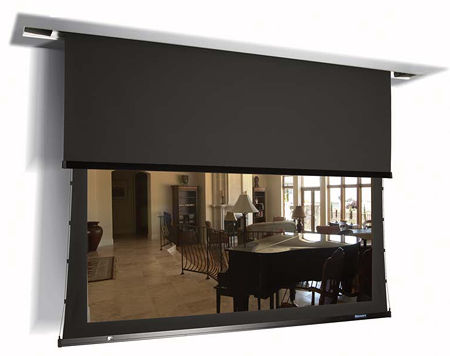
Many types of multi-aspect ratio screens are available. This design sports a black retractable panel that will mask the screen to accommodate almost any widescreen image˜or even 4:3. Photos courtesy of Stewart Filmscreen.
But at UltimateAV, we normally refer to the size of the image from a front projector and screen by its width. However, this issue is often confusing. When you order a projection screen, be sure to indicate whether you're specifying the screen's size by its width or diagonal measurement.
You can determine the width of a 16:9 screen by multiplying its diagonal measurement by 0.87. To get the height from the width, divide the width by 1.78. From these dimensions, you can determine the screen's area. That's an important number to know, because, for a given projector, as the area increases, the picture's brightness decreases in direct proportion.
As you increase the screen's width, its area increases far faster than you might think. Consider a modestly sized, 80-inch-wide screen. For a 1.78:1 aspect ratio, that screen's area is 3596 square inches (80 x [80/1.78]). If you increase the width by 50% to 120 inches, the area shoots up to 8090 square inches. That's 2.25 times the area for a 50% increase in screen width!
A projector that puts out an honest 12 foot-lamberts on the 80-inch-wide screen will max out at about 5.33fL on the larger one (with the same screen material). That's dim!
Screen Gain
The so-called "gain" of a projection screen is just as significant in determining the brightness of the image as its size. In general terms, screen gain is the ratio of the amount of light reflected from the screen to the amount of light incident upon it. "Unity gain" (a gain of 1.0) means there is no net loss or increase in the amount of light reflected from the screen compared with the amount of light hitting it.
Using this definition, a gain greater than 1.0 means that the amount of light reflected from the screen is greater than the amount of light hitting it. How can this be? A screen is a passive device; it doesn't actually amplify anything. It produces "gain" by focusing more of the light toward the center of the viewing area, presumably where most of the audience is sitting. This results in a brighter image on- or slightly off-axis, but a dimmer image as you move further to the sides. High-gain screens can also have hot spots; that is, they look obviously brighter in the center than at the sides. The higher the gain, the more pronounced the hot spot.
Many so-called "matte white" screens are specified to have a gain of approximately 1.0. Such a screen reflects light evenly over most of the area in front of it, with little tendency to concentrate its reflective output toward the center of the viewing area. Such a screen provides roughly the same brightness at all seating positions, even far off-axis.
A respected audio journalist once referred to a 1.0-gain screen he was using as having zero gain. He meant 1.0. A zero-gain screen would be a video black hole, with no light reflected from it at all!
But a screen with a gain of 1.0 can provide no assistance to a projector that could use a little extra kick in the light-output department. And its off-axis characteristics make it more likely to reflect light from nearby walls that may, in turn, reflect back onto the screen. This not only reduces contrast, but it also affects the color purity of the image (if the walls aren't painted a neutral color).
In practice, a modest screen gain can be useful. The most common screen of this type has a gain of about 1.3. Such screens are made by Stewart Filmscreen (Studiotek 130), Da-Lite (Cinema Vision), and others. They can provide a modest boost, without a significant loss of image brightness at reasonable off-axis angles, noticeable hot-spotting, or other aberrations.
While some users swear by even higher-gain screens, I generally don't recommend them. The only time I've seen impressive results from a very-high-gain screen was with a rear-projection screen from DNP used with a 9-inch CRT projector.
A screen can also have a gain of less than 1.0. Some (but not all) of these screens look gray in normal room lighting, but due to the characteristics of the eye, white picture details look white on them.
The point of a reduced-gain screeen is to produce darker blacks. The bad news, of course, is that the rest of the image is dimmed along with the blacks. But some projectors have enough output to make good use of such a screen.
The Goal
The first thing you need to determine is how bright an image you actually need. The recommendations of the Society of Motion Picture and Television Engineers (SMPTE) call for commercial movie theaters to produce a light output of 16 foot-lamberts, open gate—that is, with no film in the projector. Place a clear film frame in the projection gate—the brightest image you can get with a film running—and the output drops to about 12fL. This is an ideal that is met or exceeded only in the very best theaters using fresh projection lamps.
If I had my druthers, I'd like a peak usable light output of 16fL on my home projection screen, with a new lamp, regardless of the screen's size. That's just slightly more than in those premier commercial theaters. It's not only enough to give the image a little added punch, but it also provides enough reserve to maintain a usefully bright image after the first few hundred hours of use. My experience strongly suggests that new projection lamps lose 25-30% of their brightness during this period. (Manufacturers argue that this levels off with time, with a slower loss in the lamp's mid-life. I have not yet confirmed this.)
Realistically, you're more likely to get 12-14fL from many—if not most—home theater digital projectors on an 80-inch-wide screen. That's a visible but subtle reduction from my 16fL goal. Fortunately, our eyes respond nonlinearly to changes in brightness, so this difference is not as perceptible as the numbers might sound.
